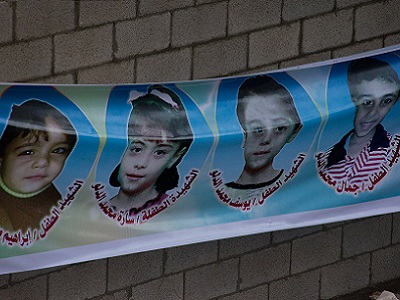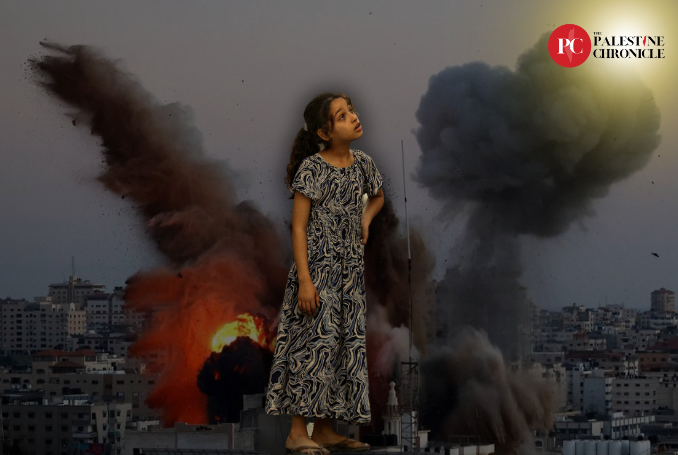
By Ramzy Baroud
When one looks at scenes of feeling refugees from Syria, browse through images of their squalid refugee camps, hears their plea for solidarity, for mercy, for God’s help to end their suffering, one finds eerie similarities between their experiences and those of Palestinians, Lebanese, Iraqis. The worse part of the tragedy, however, is when it is so prolonged, by whichever factor, to the extent, that the video footage, the photo and the personal accounts, which are meant to delineate an urgent reality, themselves become the ever-present state of affairs, a painful and humiliating status quo.
But is there a line of demarcation that people cross, where they cease to represent a real crisis – humanitarian, political, or any other – to merely subsist in their anguish, simply counting days in their UN-supplied blue tents, waiting for salvation, and getting none? What is the use of a journalist photo, when human conscious has grown numb, enough to barely appreciate the artistic expression of the photo, but not the moral and political crisis it represents?
These thoughts and more occupied my mind when Paul Hansen, a Swedish photographer, from the Swedish daily Dagens Nyheter, convincingly won, on Feb. 15, The World Press Photo of the Year 2012, which is, according to Reuters “the world’s largest annual press photography contest.”
The winning photo documented an event that has been repeated hundreds of times in Gaza in the last few years, bereaved families and neighbors, filled with pain and despair, carrying the frail bodies of little children who died in one Israeli strike on another. They walk in the alleyways of their towns or refugee camps, shoulder to shoulder, weeping, chanting and praying to God to send their little ones to Paradise. Photographers snap numerous shots, selected ones get published, and the most prized win awards. Sadly, even then, nothing changes the persistently agonizing reality.
An almost trademark demand that most victims have is for the world to know of their plight. There is a pervading impression that when the “world” know, the “world” will not allow injustice to perpetuate. Of course, it is not so simple, especially in the case of the Palestinians.
Referring to the winning photo, jury member Mayu Mohanna said, “The strength of the picture lies in the way it contrasts the anger and sorrow of the adults with the innocence of the children. It’s a picture I will not forget.” Photos taken in Palestine often reflect that very experience, a contrast between something and something else: woman crying for her demolished house while settlers celebrate a new conquest, a family terrified by a raid on their home as soldiers enthusiastically destroy their furniture, and a million more. Needless to say, they are often bloody, and ever “artistic”.
Of course, it is not exactly the responsibility of the photojournalist nor that of the photography awards judges to ensure that the meaning of the photo is diffused in such ways as to affect political and humanitarian outcomes. It is still disturbing however, that those painful conflicts are reduced to photos, footage and sound bites, and eventually appreciated for something other than the urgent and utter need to compel whatever action needed to bring people’s suffering to an end.
There is a photo of Samer Issawi, a Palestinian political prisoner who has reportedly staged the longest hunger strike in modern history, as he was wheeled from or to an Israeli court room. It was taken by activestills.org, which work has left an important mark in terms of disseminating powerful imagery pertaining to the Palestinian struggle, the Israeli occupation, and more. In the photo, Samer looks a shadow of his former-self (the already slim young man had lost 77 pounds), his hands clasped at his chest, his beard long, and untrimmed, yet his face glowing as if grateful to the man or woman who snapped his photo as he was dragged somewhere by impatient Israeli prison and court officials. Samer, naturally hopes that photo, and many others, be used as a tool to spread a message of his critical situation, but more importantly the collective cause he represents. His supporters want to achieve a similar end. Without political will, real action and pressure, that photo is likely to end up in some archive with little consequence as far as Samer’s and the freedom of thousands of Palestinian prisoners in Israeli jails are concerned.
Starting most noticeably with the First Palestinian Intifada in 1987, Palestine offered incredible photo opportunities for journalists. It was not exactly common that a whole nation take to the street, youth battling well-equipped soldiers with sling shots and empty fists for several years nonstop. Even a random photo that involves barefooted children at war against Israeli tanks would have many ‘contrasts’ and artistic worth. Then, many Palestinians were convinced that once these images reach world publics, the tide will turn in favor of Palestinian rights. In fact, to a degree, it did, as if it was suddenly discovered that Palestinians do exist beyond whatever stereotypes Israel has managed to concoct of them through its media influence, control or savvy. However, the barrier between public sentiments and government action remained erect. It would have made little difference whether US officials viewed Intifada photos or not, for the US government position on the Israeli-Palestinian conflict was never determined by such values as human rights, freedom and the right to self-determination. All the photos of all dying children will not alone alter even a single footnote in the US’s ‘unconditional support’ of Israel doctrine. These images must be coupled with passionate political activism, decided, public pressure, legal action and numerous other methods to hold Israel accountable for the gory images, and the US accountable for allowing Israel free hand to murder Palestinians.
A photo, on its own, no matter how artistic, compelling, captivating, even incensing, is not enough, if not combined or followed by a series of solid action and a clear strategy, to ensure that someday no such tragic contexts exist for photographer to freeze them in time and place.
Palestinians – and Syrians – are not mere opportunities for award-winning photos to be snapped. “My people are not animals in a zoo”, is the famous quote of Palestinian novelist and intellectual, Ghassan Kanafani to a Danish journalist, who later became his wife, as she requested to visit refugee camps in Lebanon. “You must have a good background about them before you go and visit”, he said. Kanafani was assassinated in an Israeli Mossad bomb blast, along with his niece, in July 1972, but his words endure.
Palestinians, as other peoples who are undergoing protracted tragedies are neither ‘animals in zoos’, nor mere subjects of artistic expressions, no matter how noble, or human experiments of any forms. Their tragedies, no matter how long-lasting, deserve resolutions and tangible remedies. All that victims in photos hope to achieve is for their oppression to end, not for the victimization itself to become such an accepted state of affair, and end in itself, detached from any serious political dynamics that could propel change.
– Ramzy Baroud (www.ramzybaroud.net) is an internationally-syndicated columnist and the editor of PalestineChronicle.com. His latest book is: My Father was A Freedom Fighter: Gaza’s Untold Story (Pluto Press).






A thoughtful piece. THANK YOU Ramzy!
Those of us concerned with the truth also worry, as you do, about change (or what on earth can we do for the Palestinians). As an aside, someone (I think in PC, or Richard Falk) said the accumulation of evil deeds spawned by the Israelis will have an end result in turning the world against Jews because Israel is seen as representing them. The deep hatred Israel is seeding with its bombs and bulldozers is spreading like an ink blot on blotting paper. How close we are to universal condemnation and disgust (a wholly black paper) I don’t know. But in myself what used to be (ignorant) views about the brave kibutznicks is gradually being replaced by contempt growing uncontrollably as time and the atrocities multiply. Contempt is a dangerous state without boundaries: Today Israel, tomorrow, Jews . . ? Who knows?
Ramzy, one might (cruelly ) say PC depends on the dire situation in Palestine, it too feeds off the tragedy there. Many in a globalised world similarly ‘feed’.
BUT the basis of concern, of sharing with the Palestinians a universal morality for freedom, for peace, for hope, and against war, greed and lies, gives you honour: for whom can we trust to spear-head change if everyone is dishonorable? (You’ve been implying as much in comments about PA).
Remember Pandora, the Greek princess: in her small box, almost hidden and at the last, there was hope. It’s in our box of dreams too:
HOPE!
PS: Amazon have just asked me to swap my copy of “My Father was a Fredom Fighter” for a gift token. No way! It has a special place on my book case. Forever!
Francis